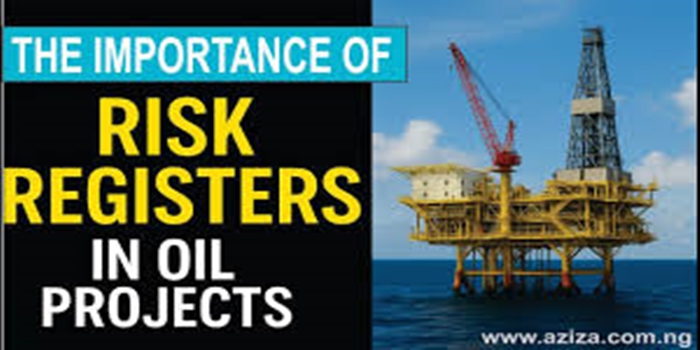In this article, we discussed risk registers in oil projects, the unique risk Profile of Oil Projects, the important, Challenges in Using Risk Registers Effectively.
Definition
A Risk Register is an organized document or database that identifies potential risks associated with a project, assesses their likelihood and impact, assigns responsibility, and outlines mitigation strategies. In oil projects, it functions as a living document that supports decision-making throughout the lifecycle of a project—from concept development to decommissioning.
What Is a Risk Register?
A Risk Register (sometimes called a Risk Log) is a formal mechanism used to:
Identify potential risks.
Assess each risk in terms of likelihood and impact.
Rank risks using a qualitative or quantitative method.
Document responses or mitigation plans.
Assign ownership for monitoring and management.
Track progress over time as risks evolve or are resolved.
Unique Risk Profile of Oil Projects
Oil projects are particularly complex and face risks in several domains:
- Technical Risks
Drilling failures, blowouts, and equipment malfunctions.
Technological integration issues.
Geological uncertainties in reservoir performance.
- Environmental and Health Risks
Oil spills, gas leaks, and flaring emissions
Water contamination and habitat destruction.
Occupational health and safety incidents.
- Financial Risks
Volatility in oil prices.
Cost overruns and budget mismanagement.
Currency fluctuations.
- Regulatory and Legal Risks
Changing regulations or licensing issues.
Compliance failures and resulting penalties.
Legal disputes with governments or local communities.
- Political and Security Risks
Nationalization of resources.
Civil unrest, terrorism, or sabotage.
Expropriation or corruption.
- Reputational Risks
Media scrutiny and public opposition.
Environmental and social missteps.
Failure to maintain a Social License to Operate (SLO).
Managing these interdependent and overlapping risks requires a systematic approach—precisely what a Risk Register provides.
The Importance of Risk Registers in Oil Projects:
Systematic Risk Management:
A risk register provides a structured, centralized tool for documenting every aspect of risk, from identification to mitigation planning and tracking.
Risk Prioritization:
By assessing the probability and potential impact of identified risks, the register helps prioritize which threats require immediate attention and resources, focusing on high-risk, high-impact issues.
Accountability & Ownership:
The register assigns ownership for each risk, ensuring clear responsibility for managing and mitigating it, which fosters a proactive risk management culture.
Enhanced Communication & Transparency:
It serves as a vital communication tool for project sponsors, senior management, and all key stakeholders, providing a clear, documented view of risks and their status.
Proactive Mitigation & Control:
The register outlines specific mitigation strategies and actions needed to address risks, enabling teams to develop and implement effective preventive measures.
Informed Decision-Making:
By providing quantitative and qualitative information about risks, the register supports informed decision-making regarding project plans, resource allocation, and contingency planning.
Monitoring & Adaptability:
As projects evolve, the risk register is a dynamic, “live” document that is regularly updated to reflect changes, new risks, and the status of existing ones, ensuring continuous oversight.
Cost and Value Assurance:
Effective risk management through a risk register helps to control project costs, protect shareholder value, and avoid potential losses by addressing threats before they escalate.
The challenges of Risk Registers in Oil Projects:
Understanding and Culture
Misunderstanding of Risk Concepts:
A fundamental challenge is a common, shared understanding of “risk” and “hazard” among diverse project personnel, notes ResearchGate.
Lack of Risk Culture:
Some oil and gas companies may lack a robust risk management culture, leading to insufficient interest from senior management and inadequate training for project engineers, according to the Project Management Institute.
Data and Metrics
Data Scarcity:
Especially in developing regions or for novel projects, a shortage of historical data can hinder accurate risk evaluation, impacting risk assessments in pipeline projects, says LJMU Research Online.
Inappropriate Risk Metrics:
There can be failures in using the correct metrics to assess risks, leading to mismeasurement of identified risks.
Subjectivity in Assessment:
Developing equivalent scales for different loss types (financial, safety, reputation) is challenging and risks subjective application, which can be reduced by providing clear guidance, according to ResearchGate.
Project and Industry Complexities
Dynamic and Volatile Environment:
The oil and gas industry is characterized by risks like geological uncertainties, fluctuating oil prices, and political instability, making risk management complex, notes ejbmr.
Broad Range of Risks:
A multitude of risks, from technical and financial to environmental and security, must be captured in a comprehensive risk register for projects like pipelines, according to ResearchGate.
Management and Communication
Failure to Communicate:
A significant challenge is the failure to effectively communicate identified risks and their potential impacts to top management, hindering timely decisions, says FutureLearn.
Lack of Dynamic Monitoring:
There can be shortcomings in the continuous monitoring and management of risks once they are recorded in the register.
Broadening the Loss Framework:
Risk registers must go beyond purely financial considerations, requiring scales for evaluating safety, environmental, technical, and reputational losses to make informed investment decisions, according to Aidic.
Examples of Risk Register Impact
- Macondo (Deepwater Horizon) Disaster
Failure to properly assess and act on known risks contributed to the 2010 Deepwater Horizon disaster in the Gulf of Mexico. A comprehensive and enforced Risk Register could have flagged well integrity issues and inadequate blowout preventer testing.
- Norwegian Continental Shelf Projects
Oil projects on the Norwegian Continental Shelf are often cited for their strong risk management frameworks. Use of detailed Risk Registers integrated into project planning and environmental reviews has contributed to their generally safe and efficient operations.
Conclusion
A Risk Register is an organized document or database that identifies potential risks associated with a project, assesses their likelihood and impact, assigns responsibility, and outlines mitigation strategies. In oil projects, it functions as a living document that supports decision-making throughout the lifecycle of a project—from concept development to decommissioning.
READ: The Role of Derivatives in Oil Price Risk Management

